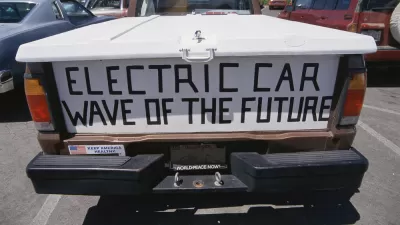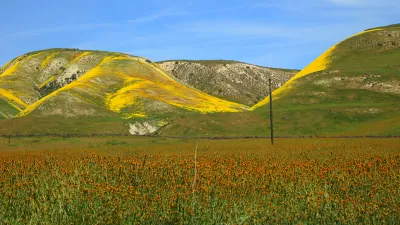Gas prices are down and sales are up, and greenhouse gas emissions from transportation, the largest source of the state's emissions, are up, even though overall they dipped. In addition to increased driving, sales of EVs and hybrids dropped.
"Recently released figures show that even as statewide greenhouse gas emissions fell slightly between 2013 and 2014, emissions from the transportation sector rose by 1 percent," reports Kate Galbraith for the San Francisco Chronicle.
Transportation accounts for 36 percent of California’s greenhouse gas emissions, more than any other economic sector, so taming it will be vital from an environmental standpoint — and hard.
Unfortunately, "2014 is the most recent year for which [greenhouse gas emission] figures are available," so the numbers don't show the full effect of low gas prices as gas prices began their steady descent in July of that year. Gas prices are reported daily by the AAA, and gas sales monthly and quarterly by the State Board of Equalization.
“One of the reasons it’s very tough to reduce emissions in the sector is that there are tremendous market barriers to clean transportation solutions,” said Simon Mui, director of the California transportation program at the Natural Resources Defense Council. Such barriers include volatile oil prices and inadequate infrastructure, he said.
It appears that by "infrastructure," Mui is referring to electric vehicle charging and fuel cell filling stations, not bus routes, light rail, or bicycle lanes.
Right now, low gas prices appear to be the biggest barrier. Prices across the state are down by [16] percent since a year ago [as of July 8], according to the American Automobile Association. (It may not feel that way to Californians, who pay gas prices that are considerably higher than the national average — a subject that recently caught the attention of California’s attorney general.)
Gasoline consumption
On July 8, gas prices in California averaged $2.90 compared to the national average of $2.25, over 22 percent higher.
People are taking advantage of cheaper gas to drive more. Sales of gasoline in California were about 2.6 percent higher in the first quarter of this year than the first quarter of last year, according to the State Board of Equalization [PDF].
People are also are favoring gasoline-fueled cars over alternatives. Electric vehicles and hybrids (including plug-ins) respectively accounted for 1.4 and 6.2 percent of all new-car registrations in California in the first quarter of this year, compared with 1.7 and 7.2 percent in all of 2015, according to the California New Car Dealers Association.
In December 2014, Planetizen posted that California fuel consumption rose for the first time in eight years. The trend continues.
Despite these headwinds, [Gov. Jerry] Brown has nonetheless stated his goal of cutting vehicles’ gasoline use in half by 2030. It’s a stringent target that would affect automakers, refiners and virtually every sector of the economy, and state lawmakers last year balked at writing it into law. Brown’s hopes rest partly on federal standards aimed at increasing vehicles’ fuel economy, as well as a variety of California programs to to nudge consumers toward more environmentally friendly options.
In addition to the Clean Vehicle Rebate Project run by the Air Resources Board, Galbraith includes two market-based measures: cap-and-trade that adds about 10 cents to a gallon of fuel and the low carbon fuel standard that will reduce carbon intensity of motor fuels 10 percent by 2020.
Vehicle miles traveled (VMT).
In December 2014, Planetizen posted about an increase of "2.6 percent from December through November of 2013 according to estimates from the California Department of Transportation [Caltrans]."
Caltrans' most recent year for VMT records is 2014, and the upward trend continues. Travel on California state highways increased 2.64 percent over 2013, according to Caltrans' 2014 Traffic Volumes booklet [PDF].
FULL STORY: Californians are driving more, which is bad for climate change

Trump Administration Could Effectively End Housing Voucher Program
Federal officials are eyeing major cuts to the Section 8 program that helps millions of low-income households pay rent.

Planetizen Federal Action Tracker
A weekly monitor of how Trump’s orders and actions are impacting planners and planning in America.

Ken Jennings Launches Transit Web Series
The Jeopardy champ wants you to ride public transit.

Driving Equity and Clean Air: California Invests in Greener School Transportation
California has awarded $500 million to fund 1,000 zero-emission school buses and chargers for educational agencies as part of its effort to reduce pollution, improve student health, and accelerate the transition to clean transportation.

Congress Moves to End Reconnecting Communities and Related Grants
The House Transportation and Infrastructure Committee moved to rescind funding for the Neighborhood Equity and Access program, which funds highway removals, freeway caps, transit projects, pedestrian infrastructure, and more.

From Throughway to Public Space: Taking Back the American Street
How the Covid-19 pandemic taught us new ways to reclaim city streets from cars.
Urban Design for Planners 1: Software Tools
This six-course series explores essential urban design concepts using open source software and equips planners with the tools they need to participate fully in the urban design process.
Planning for Universal Design
Learn the tools for implementing Universal Design in planning regulations.
Heyer Gruel & Associates PA
Ada County Highway District
Institute for Housing and Urban Development Studies (IHS)
City of Grandview
Harvard GSD Executive Education
Toledo-Lucas County Plan Commissions
Salt Lake City
NYU Wagner Graduate School of Public Service




























